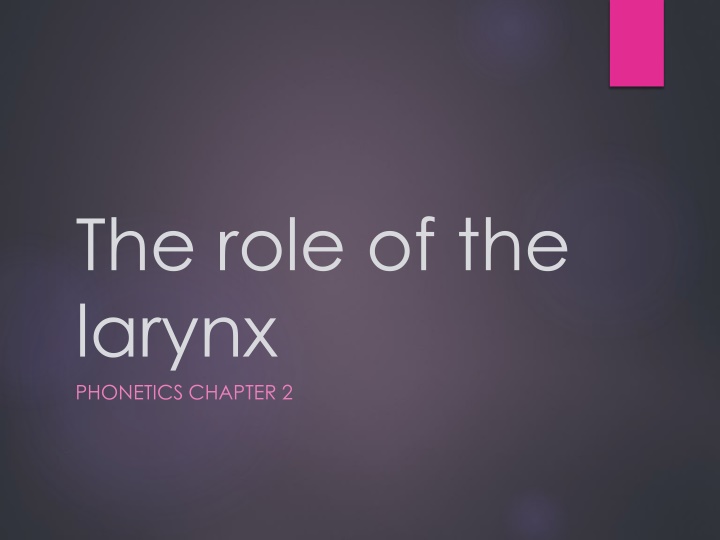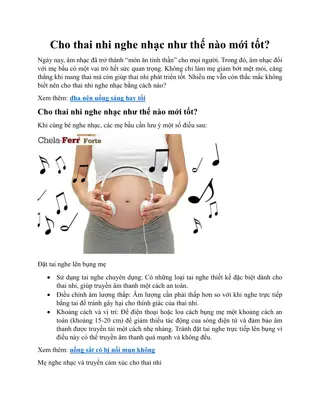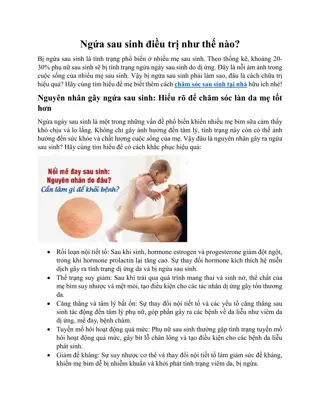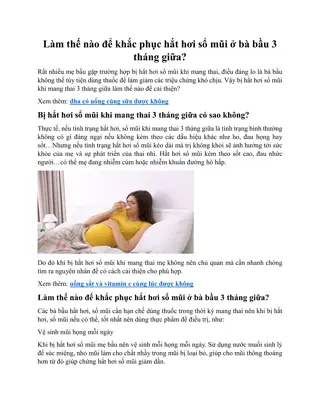The role of the
The larynx, a crucial organ in speech production, houses the vocal folds essential for phonation. This article delves into the anatomy of the larynx, the function of vocal folds, and the egressive pulmonic airstream's role in generating sound during speech. It also explores the process of speaking, highlighting the controlled expulsion of air for sustained speech. Follow the pathway of the airstream from the lungs through the trachea, larynx, and supraglottal cavities, forming the vocal tract for speech production.
Download Presentation

Please find below an Image/Link to download the presentation.
The content on the website is provided AS IS for your information and personal use only. It may not be sold, licensed, or shared on other websites without obtaining consent from the author.If you encounter any issues during the download, it is possible that the publisher has removed the file from their server.
You are allowed to download the files provided on this website for personal or commercial use, subject to the condition that they are used lawfully. All files are the property of their respective owners.
The content on the website is provided AS IS for your information and personal use only. It may not be sold, licensed, or shared on other websites without obtaining consent from the author.
E N D
Presentation Transcript
The role of the larynx PHONETICS CHAPTER 2
What is the Larynx? The larynx is a box made of cartilages, inside this box the vocal folds which are two thick flaps of a muscle rather like a pair of lips. The front wall is the thyroid cartilage, or shield cartilage , responsible for the Adam s apple (the thyroid prominence) and which is located at the front of the neck. Behind the thyroid prominence, on the inner surface of the cartilage is the anchor point for the front ends of the vocal folds. The thyroid cartilage is located at the top of the trachea (wind pipe) and controls the flow of air. The very top cartilage is a complete circle and is known as the cricoid cartilage or ring cartilage
The Vocal Folds The vocal folds are fleshy folds of tissue, they are attached at the front like the thyroid cartilage and are effectively hung like a pair of very substantial curtains across from the front to back of this structure. Muscles attaching to the aretynoid cartilages are the main force for positioning the folds in an open (abducted) or closed (adducted) position. When open, the space between the folds is called the glottis.
The egressive pulmonic airstream: The larynx or The interaction between the vocal folds and the egressive pulmonic airstream, is responsible for phonation, the sound source which is termed voice in speech. Various airstreams are used in speech but the basic one is the egressive(moving outwards) pulmonic( from the lungs) airstream. Sounds can t be produced without air coming from the lungs. The airstream comes from the lungs and goes the vocal tract The vocal tract consists of: the trachea, the larynx, supraglottal cavities (the cavities above the glottis), the pharynx, the oral cavity, and the nasal cavity.
The process of speaking (producing sounds) When we speak, we first inhale, filling the lungs with air, and then we engage in something reminiscent of what swimmers call trickle breathing . We expel the air in a carefully controlled fashion at a rather slower rate if we were just breathing out for normal breathing. This maximizes the air and allows us to speak for some time without needing to breathe in again. The expulsion is controlled or regulated by the action of muscles moving the diaphragm and by the various pairs of muscles that act on the rib cage.
The pathway (for the airstream) is thus: Out from the lungs Up the trachea Via the larynx Into supraglottal cavities( the cavities above the glottis : the pharynx(the throat), the oral cavity(the mouth) and the nasal cavity ( the nose) which also form the vocal tract.
Normal Voice Normal, chest or modal voice is the result of the vocal folds vibrating in a particular way. This happens, as soon as the speaker has inhaled, the aretynoid cartilages draw the folds (and themselves) together, then they are opened by the pressure of air which is expelled from the lungs, which is strong enough to push the vocal fold apart to produce voice. The effort being made by the aretynoid is strong enough to enable the folds to close again. They repeat on average 100 120 times per second for adult male voices and 200 240 times per second for adult female voices. In children, it can be 300 times per second. We hear this as pitch when we listen to speech, and deliberately varying the rate of vibration of our vocal folds makes our voices go up and down in pitch, adding intonation. Basically, the faster the rate of vibration, the higher the pitch of the voice.
Elastic recoil brings the bottom edges back together and then the effect passes up the folds to the top, bringing them back together in depth. This is a complex process- the pressure drop means there is also a small suction effect known as ( Bernoulli effect).
Creaky voice/ Vocal, Glottal Fry/ It is the result of an extremely low pitch voice. For some speakers of English, creaky voice is part of their idiolect. Some speakers tend to cultivate a very creaky way of speaking, female speakers of American English. Americans refer to this sound as glottal fry and the quality is sometimes an indicator of social status. The big differences between creaky voice and normal voice are that the vibratory cycles tend to be irregularly spaced in creaky as opposed to regular in normal voice and that the frequency is always very low. It could be found in a speech of a female speaker of American English.
Creaky voice is used in some African dialects to distinguish meanings of words Similarly, creaky voice is also used in Danish where it is responsible for the linguistic characteristic known as st d in which a short interval of creaky voice affects the end of certain longer vowel sounds or sonorant consonants when they follow shorter vowels. Sonorant consonants are typically those which appear as voiced only entries in the IPA chart (m-sounds, n-sounds, l- sounds, vowels, etc.).
Breathy voice Whispering and sighing are forms of breathiness, but these are also voiceless. To achieve this effect, the aretynoids draw the folds together, closing the folds themselves firmly, so that they resist the pressure from the egressive pulmonic airstream, but maintaining a gap between the two cartilages to enable the air to escape continuously at this point. Breathy voice is produced when the closure of the folds is less firm and the airstream not only escapes continuously between the open aretynoids, but also sets the folds vibrating It is mostly used in/h/ sound and when someone is out of breath.
THE LARYNX AS A PLACE OF ARTICULATION The glottis can be a place of articulation as well sounds made by the glottis are called glottal/h/. To produce this voiceless variant, a different setting is required in which the folds and aretynoids are drawn near to each other, but not touching, leaving a very small space between them such that as the egressive pulmonic air forces its way through, it becomes turbulent or disordered and makes an h-sound. Another sound is produced in the larynx, is the glottal stop [ ] found in London Englishes mostly known as t-glottalling
THE LARYNX AS A PITCH MODULATOR Lexical use of pitch: there are many languages that use pitch to make distinctions in meanings of words, these known as tone languages. In a language like English, pitch changes map over a longer phrase (called the intonational phrase). Here, a falling tone \car gives the listener the impression of a statement (it is a car) while a rising tone /car is more likely to be interpreted as a question (is it a car?). The same syllable spoken with a mid tone >car sounds as if the utterance is incomplete (maybe the speaker forgot what they were going to say next), and so on.























